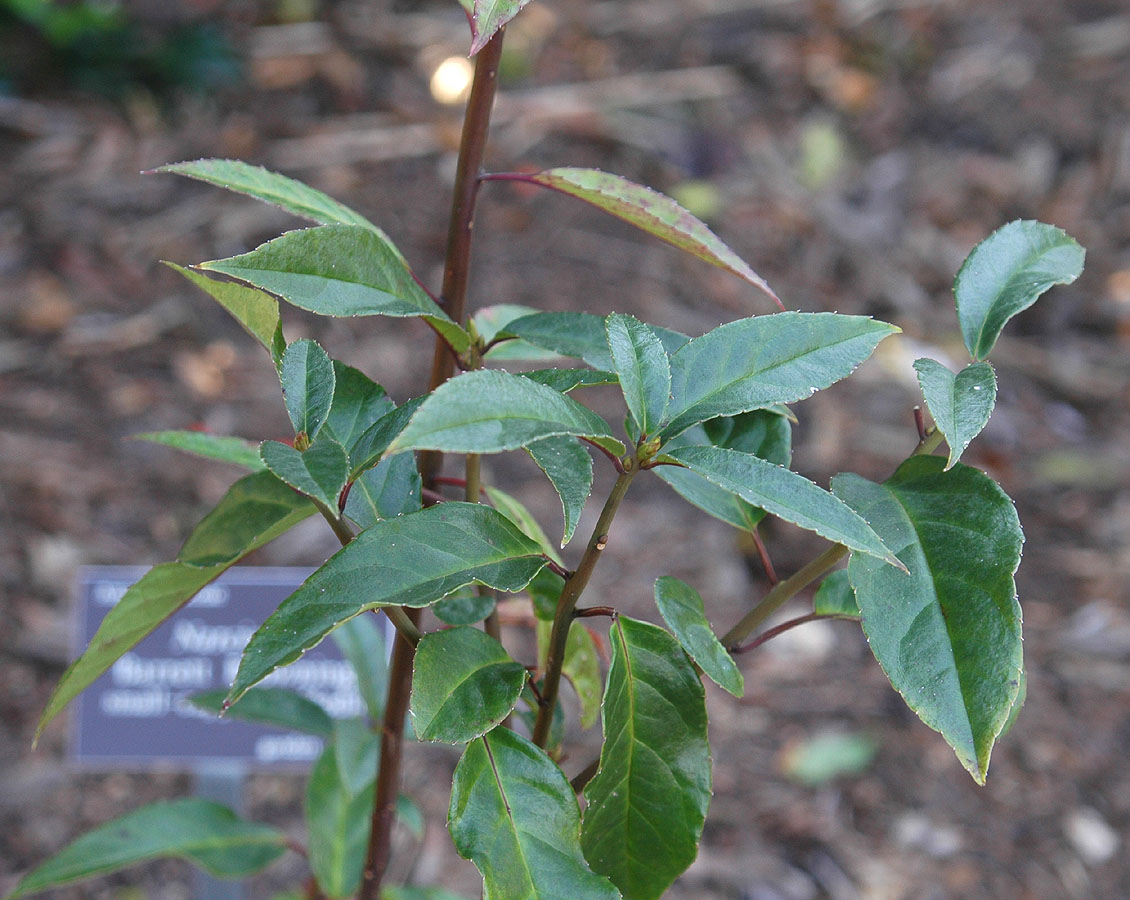HELWINGIA
PAGE
 click
image
click
image
Culberson Asiatic Arboretum, Sarah P. Duke Gardens, Duke
University, NC USA. December 2004. This is a wider-leaf form but it has the
glandular-spiculate teeth of the typical variety and unlike var. crenata.
Helwingia chinensis is super rare woody plant which we figure will become more popular in coming years. Heronswood Nursery has offered three clones of it and is responsable for much of the material around the US. It is generally an evergreen shrub of 8 feet tall and 4-6 ft. wide. Leaves are glossy green with nice purplish to red new growth and showy pigmented petioles in winter. It comes in a variety of leaf widths and sizes and is dioecious (one gender per plants) like hollies. Because they are not self-fertile, one needs at least one male and one female plant for fruitset. Heronswood conveniently offers one male, one female, and unsexed seedlings too. Leaves are said to be edible but we have no trusty data to prove this is a good thing or not.
It's real claim to fame, a truly fun curiousity is the fused peduncle (flower stem) and petiole. It makes the smallish ivory flower appear to be coming out of the leaf or leaf base quite directly. The look is pleasant and interesting with some abundance of flowers. I'm also inclined to admire the fine texture of the narrow-leaved clones for their dagger-like look and long acuminate tips. The fruit is red to purple and usually near black by ripeness. There may be some clonal differences in early fruit color that someone could study. The smallish berry adds some interest and like the flower appears fused to the leaf blade. The species is cold hardy in USDA zones 7-8. The following variations are reported:
Helwingia chinensis
[broadleaf form]
ls: wider than some clones
sex: male
so: Heronswood Nursery (online
catalog 2004)
Helwingia chinensis
var. crenata
lm: margins crenate - not glandular-spiculate to serrate as in var.
chinensis (see photo above for typical teeth)
ls: lanceolate, onlanceolate, to ovate-lanceolate - wider and not as linear-lanceolate
as the typical variety
ll, lw: 5-10cm long x 1-4cm wide - typical variety is rarely more than 2cm
wide at the most
frc: it is more red in this variety by some reports - however most all
variations are black at maturity
Helwingia chinensis
[DJHC 695]
ls: narrower type blade
lc: dark green tinged red
frc: greenish-white
sex: sold by Heronswood as unsexed seedlings
so: Heronswood Nursery (online
catalog 2004)
Helwingia chinensis var.
chinenis f. oblanceolata S.S. Chien
ls: oblanceolate
Helwingia chinensis f.
megaphylla Fang
lt: blades thinner than typical form
ls: broadly lanceolate
ll, lw: 10-17cm long x 2.5-5.0cm wide - a very long blade indeed
frd: to 1cm
Helwingia chinensis
[narrowleaf form]
ls: narrower than some clones
sex: female
so: Heronswood Nursery (online
catalog 2004)
---------------------------------------------------------------------------------------------------------------------------
Helwingia japonica is another species, not yet seen much in the US, of some beauty. It is more deciduous (semi-evergreen) than H. chinensis with leaves wider, more ovate to ovate-orbicular. They are also glossy green with black fruit at maturity. Plants tend to be a tad shorter to 5 feet. The leaves are thinner, more papery and not so thick and leathery as the Chinese species. Yokoi and Hirose in the their 1978 Variegated Plants book show a nice cream-sectored clone of this species.
LCH
All Rights Reserved.
Lawful for online access only by current society members.
All downloading, printing, saving to media, imaging, screen capture, or offline use is prohibited.
Duplication by any means, method, or technology is unlawful.
Do not link to this page.